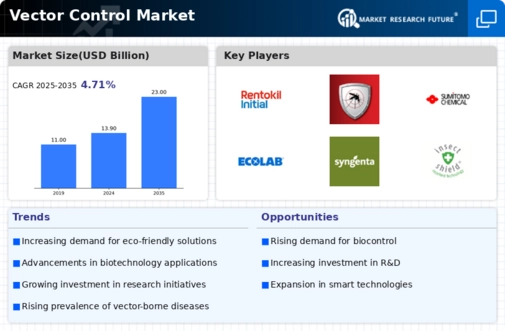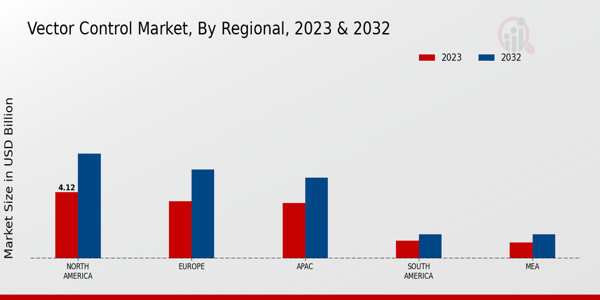Market Growth Projections
The Global Vector Control Market Industry is poised for substantial growth, with projections indicating an increase from 13.9 USD Billion in 2024 to 23.0 USD Billion by 2035. This growth trajectory reflects a compound annual growth rate (CAGR) of 4.69% from 2025 to 2035. Such projections are indicative of the increasing recognition of the importance of vector control in public health. As governments and organizations invest in innovative solutions and technologies, the market is expected to expand significantly, addressing the ongoing challenges posed by vector-borne diseases.
Government Initiatives and Funding
Government initiatives and funding play a crucial role in the Global Vector Control Market Industry. Many countries are implementing national vector control programs aimed at reducing the prevalence of vector-borne diseases. For instance, the U.S. Centers for Disease Control and Prevention allocates substantial resources to vector control efforts. This financial backing not only enhances research and development but also promotes the adoption of advanced technologies in vector management. As the market is expected to grow to 23.0 USD Billion by 2035, continued government support is likely to be a key driver in achieving these targets.
Urbanization and Environmental Changes
Urbanization and environmental changes are significant factors influencing the Global Vector Control Market Industry. Rapid urban growth often leads to increased breeding sites for vectors, such as mosquitoes, which thrive in stagnant water and urban waste. This trend necessitates enhanced vector control measures to mitigate the risks associated with urbanization. The interplay between environmental changes, such as climate change, and vector populations further complicates the landscape. As cities expand, the demand for effective vector control solutions is likely to rise, contributing to the market's growth.
Increased Public Awareness and Education
Increased public awareness and education regarding vector-borne diseases are driving the Global Vector Control Market Industry. Campaigns aimed at educating communities about prevention methods and the importance of vector control are gaining traction. Organizations like the World Health Organization emphasize the need for community engagement in vector management. This heightened awareness leads to greater demand for vector control products and services, thereby stimulating market growth. As communities become more proactive in addressing vector-related health risks, the market is likely to see sustained expansion in the coming years.
Rising Incidence of Vector-Borne Diseases
The Global Vector Control Market Industry is experiencing growth due to the increasing incidence of vector-borne diseases such as malaria, dengue, and Zika virus. According to the World Health Organization, vector-borne diseases account for a significant portion of global morbidity and mortality. In 2024, the market is projected to reach 13.9 USD Billion, driven by the urgent need for effective vector control measures. Governments and health organizations are investing in innovative solutions to combat these diseases, which further fuels market expansion. The rising awareness of public health risks associated with vectors is likely to sustain this growth trajectory.
Technological Advancements in Vector Control
Technological advancements are transforming the Global Vector Control Market Industry, introducing innovative solutions for vector management. The development of genetically modified organisms, such as sterile insect techniques, and the use of drones for targeted insecticide application are examples of how technology is enhancing vector control efforts. These advancements not only improve the efficiency of control measures but also reduce environmental impact. As the market anticipates a CAGR of 4.69% from 2025 to 2035, the integration of cutting-edge technologies is expected to play a pivotal role in shaping the future of vector control.
























Leave a Comment